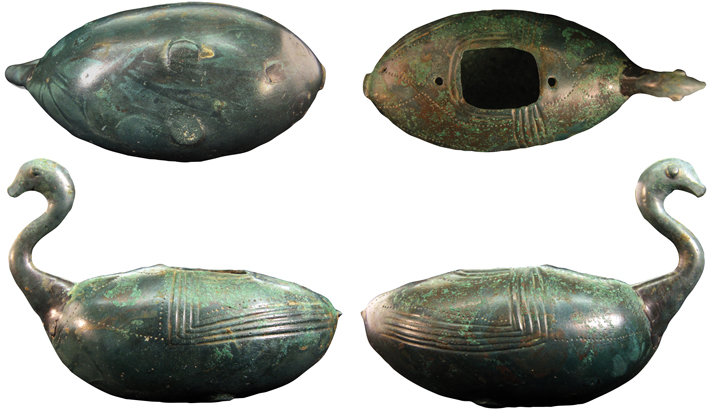Swan Songs
May/June 2021
 From 1881 to 1890, in locations including modern Slovakia, Hungary, Italy, and Bosnia and Herzegovina, a number of very similar bronze bird figurines dating to the Late Bronze and Early Iron Ages (ca. 1300–500 B.C.) were unearthed. For more than a century, it remained unclear how these artifacts were used, but their similarity was seen as evidence of shared cultural practices and beliefs across a large swath of Europe at this time. Now, a team studying a recently discovered bronze waterbird, perhaps a swan, from the site of Liptovský Hrádok in northern Slovakia, has determined that the artifact, and likely the other similar examples as well, was originally attached to a small chariot, filled with animal fat or vegetable oil and used as a lamp during burial rituals and ceremonial activities. These objects had not only a practical use but also great symbolic value, says archaeologist Filip Ondrkál of Charles University. This is especially the case in light of the emphasis members of these cultures placed on birds—particularly waterfowl—as conduits between water, soil, and air, making them central to prehistoric cosmology. To read more about birds in archaeology, clck here.
From 1881 to 1890, in locations including modern Slovakia, Hungary, Italy, and Bosnia and Herzegovina, a number of very similar bronze bird figurines dating to the Late Bronze and Early Iron Ages (ca. 1300–500 B.C.) were unearthed. For more than a century, it remained unclear how these artifacts were used, but their similarity was seen as evidence of shared cultural practices and beliefs across a large swath of Europe at this time. Now, a team studying a recently discovered bronze waterbird, perhaps a swan, from the site of Liptovský Hrádok in northern Slovakia, has determined that the artifact, and likely the other similar examples as well, was originally attached to a small chariot, filled with animal fat or vegetable oil and used as a lamp during burial rituals and ceremonial activities. These objects had not only a practical use but also great symbolic value, says archaeologist Filip Ondrkál of Charles University. This is especially the case in light of the emphasis members of these cultures placed on birds—particularly waterfowl—as conduits between water, soil, and air, making them central to prehistoric cosmology. To read more about birds in archaeology, clck here.